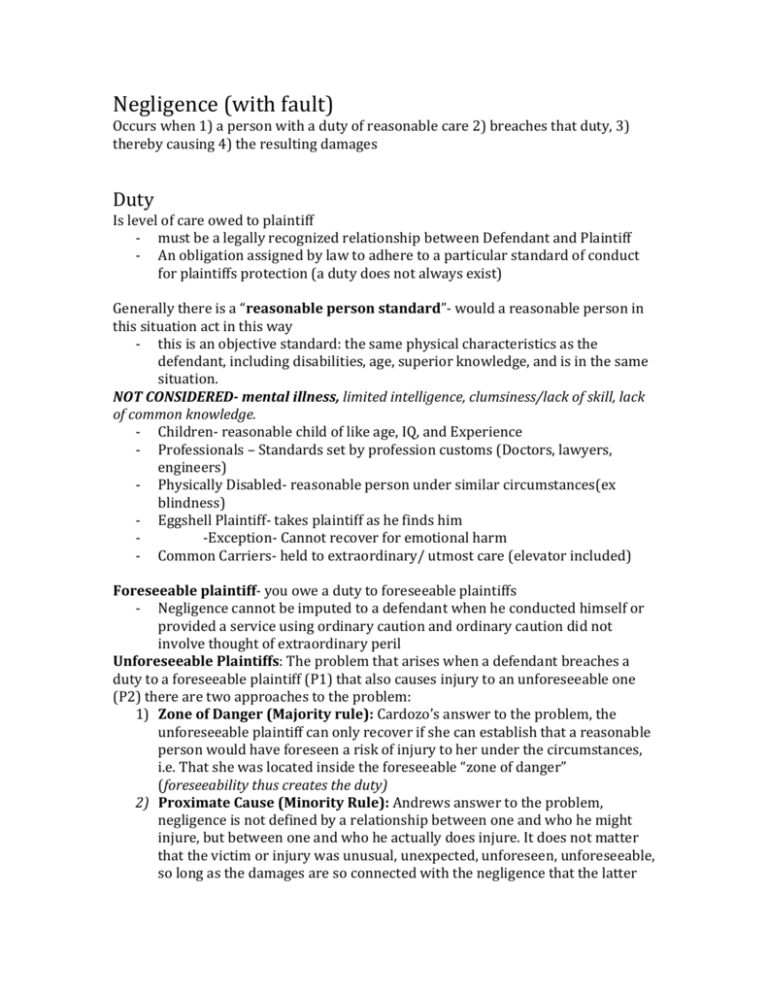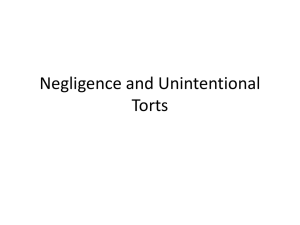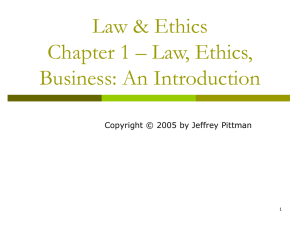Contributory negligence
advertisement

Negligence (with fault) Occurs when 1) a person with a duty of reasonable care 2) breaches that duty, 3) thereby causing 4) the resulting damages Duty Is level of care owed to plaintiff - must be a legally recognized relationship between Defendant and Plaintiff - An obligation assigned by law to adhere to a particular standard of conduct for plaintiffs protection (a duty does not always exist) Generally there is a “reasonable person standard”- would a reasonable person in this situation act in this way - this is an objective standard: the same physical characteristics as the defendant, including disabilities, age, superior knowledge, and is in the same situation. NOT CONSIDERED- mental illness, limited intelligence, clumsiness/lack of skill, lack of common knowledge. - Children- reasonable child of like age, IQ, and Experience - Professionals – Standards set by profession customs (Doctors, lawyers, engineers) - Physically Disabled- reasonable person under similar circumstances(ex blindness) - Eggshell Plaintiff- takes plaintiff as he finds him -Exception- Cannot recover for emotional harm - Common Carriers- held to extraordinary/ utmost care (elevator included) Foreseeable plaintiff- you owe a duty to foreseeable plaintiffs - Negligence cannot be imputed to a defendant when he conducted himself or provided a service using ordinary caution and ordinary caution did not involve thought of extraordinary peril Unforeseeable Plaintiffs: The problem that arises when a defendant breaches a duty to a foreseeable plaintiff (P1) that also causes injury to an unforeseeable one (P2) there are two approaches to the problem: 1) Zone of Danger (Majority rule): Cardozo’s answer to the problem, the unforeseeable plaintiff can only recover if she can establish that a reasonable person would have foreseen a risk of injury to her under the circumstances, i.e. That she was located inside the foreseeable “zone of danger” (foreseeability thus creates the duty) 2) Proximate Cause (Minority Rule): Andrews answer to the problem, negligence is not defined by a relationship between one and who he might injure, but between one and who he actually does injure. It does not matter that the victim or injury was unusual, unexpected, unforeseen, unforeseeable, so long as the damages are so connected with the negligence that the latter may be said to be the proximate cause of the former (proximate cause of injury creates the duty) - Rowland Factors!!!!! (confirm then memorize)- to be used for the “harder” cases no need to go over them in common situations - Foreseeability of Harm to the injured party - Degree of certainty he or she suffered injury - closeness of the connection between the defendant’s conduct and the injury suffered - moral blame attached to the defendants conduct - policy of preventing future harm - extend of the burden to the defendant and the consequences to the community of imposing a duty of care with resulting liability for breach - availably, cost, and prevalence of insurance for the risk involved - social utility of the defendants conduct from which injury arose (added later) Landowner Liability - Invitee/ Licensee/Trespasser Invitee: A person who is invited to enter or remain on land for a purpose directly or indirectly connected with business dealings with the possessor of the land, or person who is invited to enter or remain on the land as a member of the public for a purpose for which the land is held open to the public 1) Duty: reasonable care to warn or otherwise protect from known dangers, and reasonable care to inspect for and discover such dangers. Also must employ reasonable care not to injure negligently. 2) Examples: Store patrons, postal carriers, public swimming pools, job applicants 3) Note: when invitee goes beyond the area of invitation, he drops down to licensee or even trespasser - - Trespasser- had no right at all to be on the land - Licensee- came on the land with owners consent, but as a social guest - Invitee- came with a business purpose TODAY- licensee and invitee have combined Failure to act(Nonfeasance) No duty to act unless - Creating the peril: there is a duty to rescues when the need arises because of the defendants negligence - Minority- impose a duty even with the innocent creation of risk - One who undertakes to act may no discontinue assistance if he has, in some way, put the plaintiff in a worse condition than he would have been had nothing been done - (modern); also imposes that once a person chooses to act, must act reasonably EXCEPTION: good Samaritan acts can limit liability to gross negligence/ recklessness Contract: obligation to rescue can arise from a contract Identifiable victims: duty to warn “readily identifiable victims”: when a defendant knows a serious danger towards others (and the intended victim is readily identifiable), an affirmative obligation to use reasonable care to warn the victim arises Alcohol Commercial Vendors are liable for personal injury or property damage to 3rd parties caused by an intoxicated person resulting from sales of alcohol made to obviously intoxicated persons and to MINORS. - Liability to intoxicated minors themselves widely permitted - Liability to intoxicated adults themselves less frequently permitted - CALIFORNIA RULE- no liability, except for sale to “obviously intoxicated minors” which proximately cause personal injuries. Social Hosts: - have NO DUTY to intoxicated adults and 3rd parties they injure - OWE A DUTY to intoxicated minors and 3rd parties they injure - CALIFORNIA RULE- no liability whatsoever for social hosts Breach Is defendant acting unreasonable under the circumstances (foreseeable risk of harm) - Learned Hand Formula (B>PL) burden avoided greater then probability times amount of loss - 1) the Probability that the incident causing the injury will occur. - 2) the extent of Liability of the injury - 3) the Burden of adequate precautions - a. B< PL= duty/ negligence - b. B>PL= no duty/ no negligence - Res Ipsa Loquitur- the accident speaks for itself (common law) - (Burden shifting in breach) - accident usually doesn’t occur in absence of negligence - instrument causing accident in sole control of defendant - plaintiff is not at fault Impact - Jury can infer negligence - rebuttable presumption - - incentive to defendant to provide evidence - Often the plaintiff is unable to provide evidence (e.g Medical cases) - multiple defendants- hard for P to prove which, let them provide evidence exonerating themselves Custom- Duty can be different based on what a reasonable person does in that field. Ex a chair must be designed to be stood on; Doctors have a higher duty based on their knowledge and must adhere to industry standards - if defendant can show he conformed to custom he may establish due care - plaintiff has burden to show there is a safer way that is not prohibitively expensive to implement Common Carriers (includes elevators) - California rule: required to exercise a very high degree of care towards their passengers and guests ie. They are liable even for slight negligence. Causation Is why the accident occurred: The element of causation requires that the negligent conduct is appropriately linked/ associated with the harm. The defendants acts must have been both the 1) cause in fact and 2) proximate cause of the plaintiffs injury Cause in Fact (actual cause of harm)- the physical or scientific link between the breach and the harm in general use the but for test - “but-for” test- accident would not have occurred “but for” defendants action - Substantial factor test- defendant materially contributed to plaintiff injury A) Only when multiple redundant causes create a single injury; either would have been enough to cause the harm B) Joint and Severable Liability - Each defendant must have acted unreasonably - Each must be sued by the plaintiff - ( Damages go to percentage caused by each individual; if one cant pay other is responsible for full amount but can be sued by other defendant to get the money back) Proximate Cause: is foreseeable harm test (forseeablity or legal link) Adds to the cause in fact requirement by precluding recovery when the causal relationship between the defendant’s conduct and the plaintiffs injury does not justify imposing tort responsibility on the defendant. The modern view looks at 1) the extend of the harm, 2) the type of the harm, 3) the manner of the harm 1) Extent of the harm= the defendant takes the victim as he finds him and is liable for all consequences no matter how extraordinary (eggshell/ thin skinned plaintiff rule) 2) Type of harm= the harm actually suffered by the plaintiff must be within the risk created by the defendants negligence 3) Manner of harm= requires that there not be an intervening force so unforeseeable that it is deemed superseding and would thusly relieve the negligent actor of liability a. Courts have held that the original tortfeasor will be liable for additional injuries received in the subsequent treatment of the original injury in absence of gross/ reckless/ intentional medical misconduct b. A defendant is only liable for only those consequences of his conduct that are reasonably foreseeable at the time he acts. Damages Is what is owed to plaintiff when defendant found guilty (victim must try to mitigate losses when possible) Defenses 1) Contributory Negligence - Plaintiffs negligence is a complete bar to recovery for defendants negligence - Exception- “last clear chance”- if defendants negligence occurred AFTER plaintiffs contributory negligence 2) Comparative fault- current standard (occurs when plaintiff is negligent in causing their own injury) 3) Pure- reduce damages by the amount they are negligent - It must be decided the percentages of fault- if over 50% it is a complete defense; if under it is a partial defense - Usually they must pay the percentage of fault they are deemed to have created Respondeat Superior(employeer-employee) Servant-master relationship- employers power to control how employee does their job Employer liable for employee’s conduct, not vice versa Liability for torts committed within the SCOPE OF THE EMPOYMENT (Birkner FACTORS) - Employee must be about the employers business, not on a personal endeavor - conduct must occur within the hours and ordinary boundaries of the employment - conduct must be motivated, at least in part, but serving the employers interest No liability for intentional torts committed unless the employer directed the conduct No liability for independent contractors, unless apparent agency/ authority - Representation by the purported principal (falsely present themselves) - Reliance on that representation by a third party - Change in position by the third party in reliance on that representation Statute Compliance with a comprehensive statue- no negligence Violation of statue without excuse is negligence per se (a method in which plaintiffs can use to establish a statutory duty of care, violation of such a statute gives a presumption conclusion of duty and breach. - type of harm that occurred needs to have been intended to be prevented by the statute Statute applies if it was enacted… ELEMENTS ARE - to protect the class of persons (including plaintiff) - to protect the particular interest which is being invaded - From the type of harm which has resulted - And to protect against the particular hazard Excuses (ie affirminating defenses) for violating statute - Necessity - Safer to not comply then to comply - Relevant only when applying a statute for negligence - Emergency - Incapacity - Reasonable ignorance of fact or risk DEFENES!!!!!!! Intential Tort - the person acts with the purpose of producing the consequence the person acts knowing that the consequence is substantially certain to result BATTERY Battery is 1) an intentional act resulting in 2) a harmful or offensive, 3) unprivileged 4) contact 1) Intent= purpose to cause tortuous contact OR substantial certainty that such a contact will result a. Transferred Intent = actor is liable when attempts *intentional* tort but causes another 2) Offensive / harmful = reasonable person under the circumstances would find this contact harmful/offensive (at the time) 3) Unprivileged a. To be privileged, one must be 1) aware of the impending act AND 2) give implied/express consent 4) Contact = invade physical integrity a. Extended to objects intimately associated with victim’s body ASSAULT Assault is 1) an intentional act that 2) creates reasonable apprehension of 3) an imminent 4) harmful or offensive contact 1) Intent = purpose to cause tortuous contact OR substantial certainty that such a contact will result a. Transferred Intent applies b. Words alone are usually not sufficient, but depends on the circumstances 2) Apprehension = perception of anticipation 3) Imminent = no significant delay a. Need not produce fear in the victim [R2T 24 comment b] 4) Offensive / harmful = reasonable person under the circumstances would find this contact harmful/offensive a. Conditional Assault = an assault made conditional on a victim’s compliance is unlawful UNLESS defendant has a right to make such a threat STRICT LIABILITY Under strict liability, a plaintiff may recover for injuries sustained as a result of some act or omission of the defendant, even if the defendant used the utmost care. The policy is that such liability is imposed a matter of public policy. If a defendant wishes to engage in certain dangerous activities, that must pay their own way to do so – including the harm caused to others. Animals 1) Strictly liable for WILD animals 2) NOT for domestic animals UNLESS there is proof that the defendant knew of the dangerous propensities of the animal a. Notice issue i. No affirmative duty to discovery the traits of the animal ii. Expected to posses common knowledge regarding the animal iii. What characteristics would put a RSP under notice of the dangerous propensities? b. Dog bites are statutorily regulated Abnormally Dangerous Activities A defendant may be held strictly liable for engaging in abnormally dangerous activities, or “ultra-hazardous activities.” [R2T 519-520] The factors for determine such are as follows: 1) Probability of the harm 2) Likely gravity of potential harm 3) Inability to eliminate risk by exercise of reasonable care a. Plaintiff must show that the risk involved is inevitable 4) Extent of the activity is not a matter of common usage 5) The inappropriateness of the activity to the place where it is carried on 6) The extent to which its value to the community is outweighed by its dangerous attributes Defenses to Strict Liability 1) Contributory negligence is NOT a defense to strict liability 2) Primary assumption of risk acts a complete bar to recovery under strict liability 3) Under Comparative negligence / secondary assumption of risk, is a partial defense to strict liability NEGLIGENCE DEFENSES CONTRIBUTORY/COMPARATIVE NEGLIGENCE DEFINITION Contributory / Comparative negligence is defined as conduct on the party of the plaintiff which falls below the standard of conduct to which he should conform for his own protection, and which is a legally contributory cause … in bringing about the plaintiff’s harm. Depending on the jurisdiction: if the law is contributory negligence (a minority), the plaintiff’s own negligence acts as a complete bar to recover. If the law is comparative negligence (majority), the plaintiff’s recovery is reduced by the proportion that his own negligence bears to total negligence. (Under modified negligence, the plaintiff is allowed partial recovery until the plaintiff is more or equally (depending on jurisdiction) negligent than the defendant). Contributory negligence – Last Clear Chance Doctrine The Last Clear Chance Doctrine instruct the courts to disregard the plaintiff’s negligence if the defendant’s negligence occurred AFTER the plaintiff’s contributory negligence. Hence, if the defendant had a “last clear chance” to avoid the accident, then contributory negligence would NOT be a defense. [Davies v. Mann]. Comparative fault / negligence – Rejects Last Clear Chance Doctrine Most jurisdictions reject the last clear chance doctrine when replacing contributory negligence with comparative negligence. ASSUMPTION OF RISK DEFINITION Assumption of Risk occurs when a plaintiff 1) knows a particular risk and 2) voluntary 3) assumes it. 1) Knows (subjective test) 2) Voluntarily 3) Assumes (ID express v. implied AND primary v. secondary) a. Express assumption = plaintiff agrees to accept a certain risk i. Can be invalidated if found contrary to public policy b. Implied assumption = plaintiff accepts the risk by simply engaging in the activity with knowledge of certain risks c. Primary assumption = plaintiff either expressly or impliedly has consented to relive the defendant of an obligation or DUTY to act in a certain way towards him i. Acts as a release from liability ii. Express assumption completely bars a claim resulting from risks actually assumed iii. Implied assumption bars a claim resulting from the specific known and appreciated facts d. Secondary assumption = plaintiff is aware of a risk that has already been created by the negligence of the defendant yet chooses to voluntarily encounter it i. This assumption of risk is not truly consensual, but a form of contributory/comparative negligence 1. In which negligence consists of making the wrong choice by voluntarily encountering a known reasonable risk a. NOT a complete bar, but a reduction in damages barker factors are for design defects p. 572 1) product as designed causes harm even when used properly 2) Proximate cause 3) B v PL 1) Cost of designing the product to prevent the risk 2) The effect the redesign would have on the utility of the product 3) Extend of the risk the product posses









